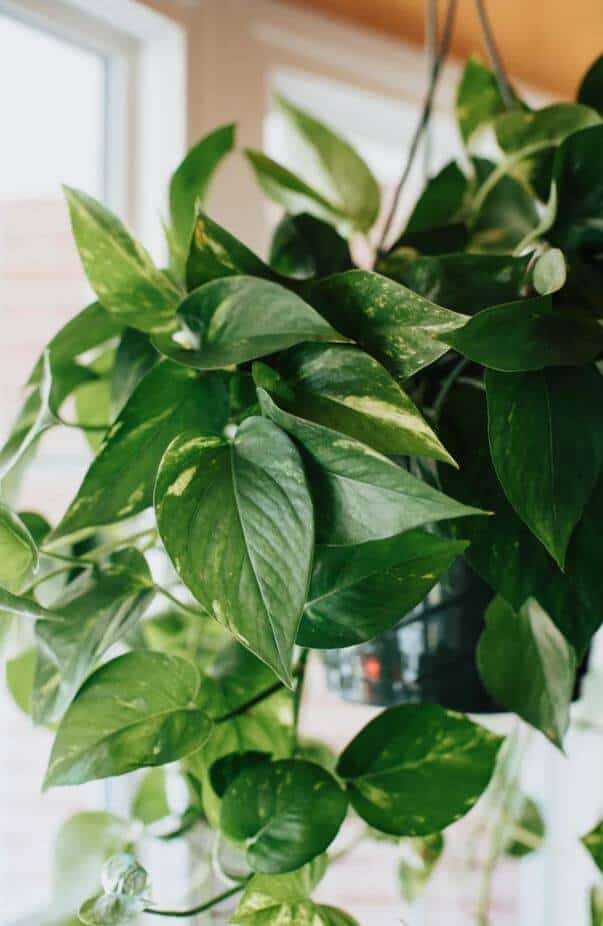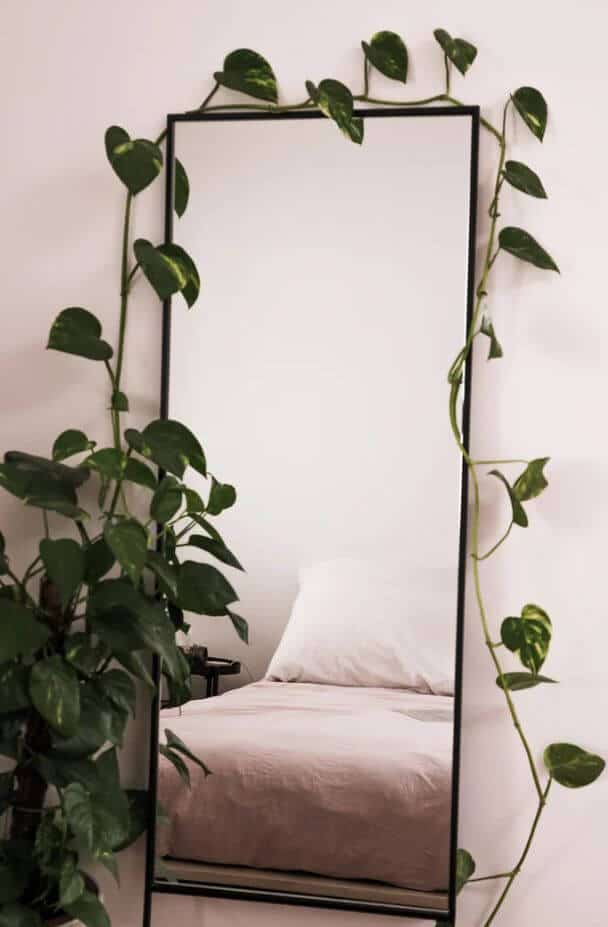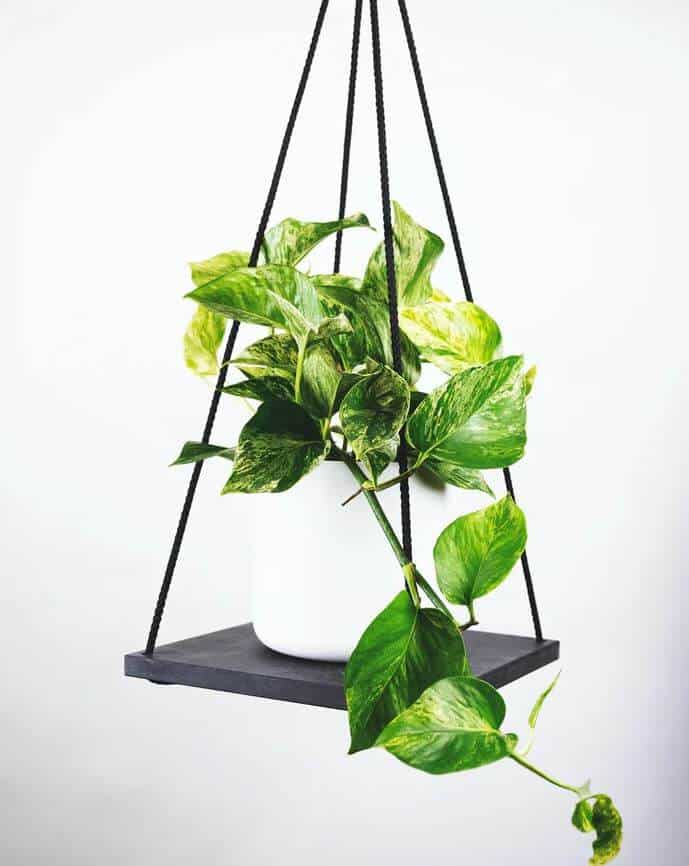Last Updated on January 11, 2023 by a Friendly Gardener
Even without a green thumb, you can cultivate indoor houseplants to cheer up home décor with a bit of greenery. For those of you that are new to indoor gardening, or haven’t had much luck in the past, consider the lovely Pothos plant.
About Pothos
Pothos botanically called the Epipremnum Aureum, commonly named “devil’s ivy”, is one of the easiest houseplants in existence to cultivate. Native to tropical forests in the Caribbean, Mexico, and South America, it is a popular addition to offices, homes, and businesses globally. As an evergreen, it will flourish year-round with good care. An interesting thing to know is that there’s a variety of this plant that is absolutely massive, the Giant Pothos plant.
Characterized by trailing jungle vines that fill with vibrant heart-shaped green leaves it is a stunning decorative plant that lends itself to hanging baskets, high shelves, ad bookcases among others. Foliage will generally be variegated, although some cultivars boast solid green leaves.

Another great advantage of the Pothos is that it does well in low-light conditions. If you have avoided cultivating houseplants because your home or office doesn’t get direct light or much at all, consider the Pothos and you won’t be disappointed.
It also does not require a great deal of attention, so if you travel a lot, are busy, or just forget the Pothosneeds limited care.
Pothos is referred to by several popular names including
- Golden pothos
- Hunter’s robe
- Taros vine
- Money plant
- Ivy arum
- Devil’s Ivy
When growing in its natural rainforest habitat, it can be quite large and invasive.
If your Pothos vines grow too long, simply prune to arrive at the preferred shape of your plant and vine length. Dried-out or yellowing leaves should be removed.
Pothos Plant Care
Soil
Pothos plants prefer dryer soil as opposed to soggy. They should not be left to sit in a wet soil bed. Your potting mix needs to be well-draining. Perlite or coco coir can be added to potting soil to improve drainage. The soil needs to balance water retention with drainage. Soil pH is better when slightly acidic measuring between 6.0 and 6.5. You can mix your growing medium using one part pine bark, two parts peat moss, and one part perlite.
Should the topsoil remain wet, there is most likely a drainage problem. Renew the soil mix. If the plant’s roots sit in water, your plant will drown. To repot your pothos, change the soil entirely. Repot if the plant appears rootbound.
Light
Pothos does not do well in direct bright sunlight. This will place it at risk for burnt foliage. It does love bright, indirect light. Pale leaves indicate too much sun. If you have a variegated Pothos that loses variegation, this signals too little light. Leaves may turn entirely green as a result.
Temperature
The ideal temperature for the Pothos should measure between 70°F. and 90°F. Temperatures that fall under 70°F or that raise above 90°F. will slow your plant’s growth.

The Pothos can survive a temperature dip to 50°F. on occasion, but anything lower will be lethal. If you live in a colder climate, avoid cold drafty windows. Tropical Pothos prefers warm and humid environments.
Water and Humidity
The Pothos generally does well with weekly watering, especially in spring and summer. For a hot, arid climate, twice a week may be better. In fall and winter, water once every ten days to two weeks. Drooping leaves indicate thirst. A lack of water for too long will cause leaf drop. While the Pothos can survive some drought, they will not survive being overwatered. When foliage changes color, look to water-related issues.
Pothos likes its humidity above 50%. To increase humidity, add a space humidifier. Misting works until the plant dries but increases the risk of fungal infestation. Occasional misting is fine. In humid areas, misting will not be necessary and may create problems if air circulation is insufficient. Pothos plants do well in bathrooms. To check your humidity use a hygrometer, that can test the relative humidity in any room.
Signs of low humidity include:
- Drooping leaves
- Brown edges on foliage
- wilting
- Yellowing leaves
These can also indicate a lack of water.
Location

This plant is ideal for placement on a ledge, bookshelf, or in a hanging basket. Vines cascade downward, so placing your plant high up displays its full beauty. You can also insert a pole or a trellis to train it upward.
Fertilizing
The Pothos is a light feeder, so feeding once a month will be fine. Use a balanced water-soluble fertilizer, compost solution, or seaweed solution. Fertilizers with higher nitrogen encourage foliage growth.
Pruning
Pruning is important for the Pothos. Otherwise, it will continue to grow in length, often becoming leggy. Use clean sterilized scissors to cut the Pothos tips. This stimulates side growth. Pothos clippings can be used to create new plants.
Common Plant Pests, Diseases, and Problems
Common tell-tale signs of problems include:
· Yellowing foliage
The soil mix is not ideal. Your Pothos doesn’t have sufficient oxygen so your soil bed may not be draining properly. There also may be a fungal problem from overly wet root conditions. Allow the soil bed to dry out before watering again.
- Soft roots or soft tissue
If growing just above the soil surface, this indicates a fungal problem. Check the soil and drain excess water.
· Wilting
The plant needs water. Check the leaves. If they feel soft, the plant needs some attention.
· Foliage changes color
Leaves that are yellow indicate overwatering or too much direct exposure to sunlight. Spider mites may be feeding on the leaf undersides, so they turn yellow. To contrast spider mites spray infected leaves with insecticidal soap. Yellow leaves can also indicate too little or too much fertilizer.
· Pests
Spider mites love the Pothos. These mites are white and feed on new foliage, leaving holes. Spray your plant with organic neem oil or a neem solution making sure to spray all foliage.
Neem oil should resolve any pest infestations.
Pothos and Pets

Pothos is poisonous for both humans and animals if chewed or ingested. Place it out of the reach of children and both cats and dogs.
The Pothos contains calcium oxalate which irritates the digestive tract and the mouth. Vomiting, drooling excessively, or difficulty breathing, require a veterinarian and inform the doctor that you suspect Pothos poisoning.
Symptoms of Pothos poisoning include:
- Diarrhea
- Vomiting
- Foaming at the mouth
- Excessive drooling
- Pawing of the mouth or oral cavity.
- Mouth pain or discomfort
- Difficulty when swallowing
- Mouth, eyes, lips, or tongue irritation
- Difficulty breathing
- Loss of appetite
- Tremors
Pothos is also not an aquatic plant and should not be introduced into an aquarium.
Pothos Propagation
Cut a piece of your pathos vine and place the stem section with a node in a glass of water. Nodes are brownish in color. Water should be changed every several days. If municipal water has a high chlorine content, use bottled water. Wait for root development in approximately two weeks. Transplant into potting soil.
A Final Thought

This is one of Nasa’s listed air-cleansing plants, removing benzene and formaldehyde fumes as well as carbon monoxide from the environment. With its low maintenance and lush foliage, it will be a welcome addition to any room.

